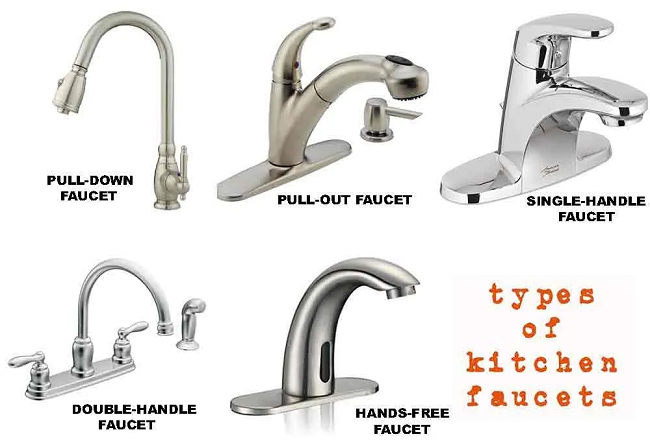Whether you are choosing a new faucet for your kitchen or bathroom, it’s important to know the differences between these four basic types. The spout is the part of a faucet that delivers water to the sink. The spout can be designed to add style and flair to your bathroom or kitchen. Straight spouts provide long reach with a low profile, while gooseneck spouts feature a graceful high-arc shape. Shepherd’s crook spouts can be useful for filling deep pots, while articulating spouts feature multiple joints for flexibility.
What Are The 4 Types Of Faucets?
There are four basic types of sink faucets. The first is the single-handle type, which controls hot and cold water. This type is easier on joints than two-handle faucets. Single-handle faucets can also be sensor-controlled, which allows you to control the flow of water without touching the faucet. Single-handle faucets typically feature a separate spout and handle and are mounted to the sink deck or countertop.
The other three types of faucets differ in their materials. The material is an important factor because it determines the longevity of the faucet. If you plan to use your faucet frequently, consider purchasing one with high-quality material. Some common faucet materials include stainless steel, bronze, nickel, pewter, and lead. Other factors include the finish, which determines the look of the faucet. Several finishes are available, but most are correlated with color.
A good faucet must have the adequate reach or the ability to swing over a large area of the sink basin. The reach of the faucet is the horizontal distance from the opening to the faucet’s connection. A pull-out or a pull-down faucet does not have this reach problem.
How To Choose The Right Faucet?
When choosing a faucet, it is important to consider the overall style and finish. Certain finishes are more durable, while others are more affordable. Popular finishes include stainless steel and chrome. Whether the faucet is for a kitchen or a bathroom, there are many options to choose from. In addition, the size of the faucet should be considered. A 4-inch faucet is best suited to a tight space, while an 8-inch faucet is more appropriate for larger spaces. While a 4-inch faucet will fit well in a small space, it will also require a larger area to clean.
While a 4-inch faucet has a spout attached to the sink’s deck plate, an 8-inch faucet has a separate handle and spout. Some bathrooms have space for both.
What Are The Types Of Kitchen Sink faucets?
When it comes to kitchen sink faucets, you have many different options. Some of them are powered by electricity, while others use a battery. It would be best if you considered which works best for your home. Pull-out faucets are modern and convenient. They allow you to reach hard-to-reach areas easily. They also tend to have lower sprout levels.
Another popular style is the spout. Separate handles control cold and hot water on these faucets. They require two holes in the countertop, but they offer convenience and separate control over water flow. However, they can be difficult to install in tight spaces and unsuitable for large basins or filling tall containers.
One of the most common options is a deck-mounted faucet. This type of faucet requires two holes in the sink and countertop. This allows for more countertop space and makes cleanup easier. However, it’s not recommended for exterior walls in colder climates.
What Is A Faucet On A Sink?
A sink faucet is a piece of basic plumbing equipment that allows you to control water flow. It is the most common type of faucet and comes in different styles and configurations. A typical single-handle faucet has a single lever that you can turn to change the temperature and water pressure. However, you can also find faucets with two handles that offer more flexibility and control over hot and cold water.
Most kitchens run off the city’s water supply, which is pressurized. Without a faucet, the water will splash out of the pipe. A faucet allows water to flow when the handle is depressed, or it can stop when it is released. Some faucets have two handles, allowing water to flow either way or be angled.
Another type of faucet is the ball faucet, which uses a single handle. The ball is mounted inside the faucet body on a spring system. It can rotate side to side and up and down, allowing you to adjust the temperature and water flow. If the water leaks, it is most likely caused by a faulty spring or a loose adjusting ring.
How Many Types Of Faucets Are There?
There are many different types of faucets for your sink. Some of these faucets have finishes meant to “age” or “tarnish,” while others are made with materials that won’t tarnish. These faucets often come in brushed nickel, bronze, polished brass, and stainless steel. Some even have additional features.
Depending on the type, you can choose between single handles and 3-hole faucets. Single-handle faucets feature one lever for water pressure and temperature control, while three-hole faucets feature two handles and one spout. Side-spout faucets are generally cheaper and have a more classic look, but they are only sometimes compatible with modern kitchen designs.
The traditional type is typically seen in kitchens. It has one handle that can be moved up and down to adjust the water temperature. A single-handle faucet is more convenient for small spaces, as you only need one hand to operate it. It also requires fewer holes for installation. Single-lever faucets are also cheaper and easier to install. Choose a faucet that complements the size of your sink.
What Kind Of Sink Faucet Do I Have?
The first step in figuring out what kind of sink faucet you have is to locate the brand and model number of your faucet. This can be found on the label or tag beneath the sink, countertop, or bath rim. You can also look for the number in the manual or instruction booklet with your faucet.
Many manufacturers make replacement stems for your faucet. Make sure to note the stem manufacturer, its length and spline shape, and how many teeth are on the stem. Take the old stem with you when shopping because you can check to ensure that it matches the replacement stem.
Another consideration is where you’ll mount your faucet. Some faucets mount to the wall, while others have holes drilled into the sink countertop. Be sure to choose a faucet style that doesn’t interfere with the shape or size of your sink. If your faucet is wall-mounted, you’ll need to install extra hardware to mount it properly.
How Do I Choose A Sink Faucet?
There are many factors to consider when choosing a new faucet for your sink. You need to consider the size and shape of your sink and the type of faucet you want. You will also need to consider the color scheme of the room. The type of faucet you choose should complement the rest of the room’s decor.
The height of the faucet is another consideration. You want to choose one that fits comfortably over your sink. Neither too high nor too low is acceptable. A faucet with too high of a spout can be uncomfortable or splashed. Ensure you measure your sink’s height and ensure the faucet is right.
The color and finish of your faucet are also important. The faucet you choose should match the rest of the room’s decor and the style of the appliances in the room. Remember, you will look at it daily, so you want it to match the rest of the decor. If you go with the wrong color or finish, it can make the room look dingy.
What Kind Of Bathroom Sink Faucet Do I Have?
Bathroom sink faucets come in a variety of styles. Most are made of metal, but some are made of plastic or rubber. They’re all recyclable. Check if your city has a recycling center or company that accepts these items. If not, you can always take them to a scrap yard.
One of the most important things to do before installing a new faucet is to identify your type of faucet. This is important because the types of faucets can require different tools and installation methods. If you plan to install the faucet yourself, make sure to know which type you have so you can choose the right tools. Be sure to note the location of the existing connections and the amount of space available on either side of the sink.
Another important factor to consider when choosing a new faucet is its design. Many faucets use lever handles or cross handles. Lever handles are easier to turn and are easier to operate than knobs. You should also ensure enough room in front of your backsplash to turn the handle.
Conclusion
The next time you have a plumbing problem, knowing how to fix compression faucets, disc faucets, ball faucets, and cartridge faucets could come in handy. Some cartridge faucets have one handle, and some have two. Either way, the handle will conceal a hollow metal cartridge that moves in response to the handle being manipulated. Ball faucets were designed to be the first washerless faucets. Unlike compression faucets, a ball faucet only has one handle for hot and cold water. The water’s temperature, pressure, and flow rate depend on where you position the ball faucet handle. Generally identifiable by its single-lever control and wide, cylindrical body, a disc faucet controls the temperature of the water with two ceramic discs at the bottom of the chamber inside.
The lever ball assembly controls a rotating ball on a ball faucet. Electronic faucets are also worth mentioning. They were invented in the 1950s but saw widespread use in the ’80s. They often use infrared sensors to disrupt a compression faucet and let the water flow. It can identify a compression faucet by its two handles and the fast rotating motion needed to stop the water flow. Pressure balance cartridges mix cold and hot water inside the disc faucet. Kitchens and bathrooms’ double-handle cartridge faucets look almost indistinguishable from compression washer faucets.



